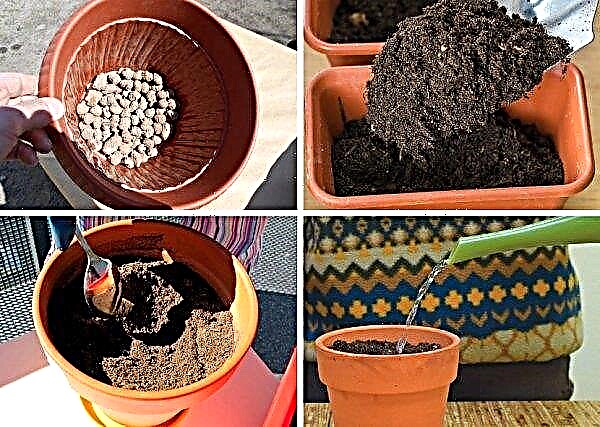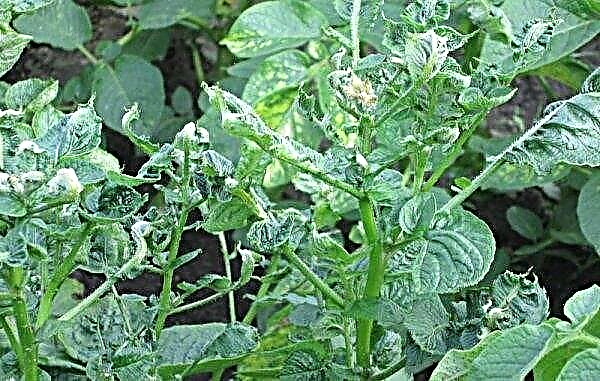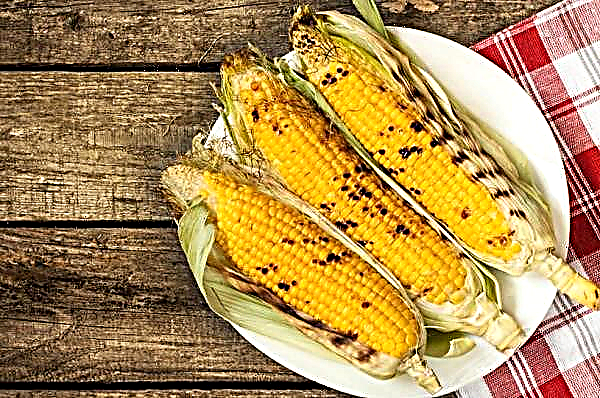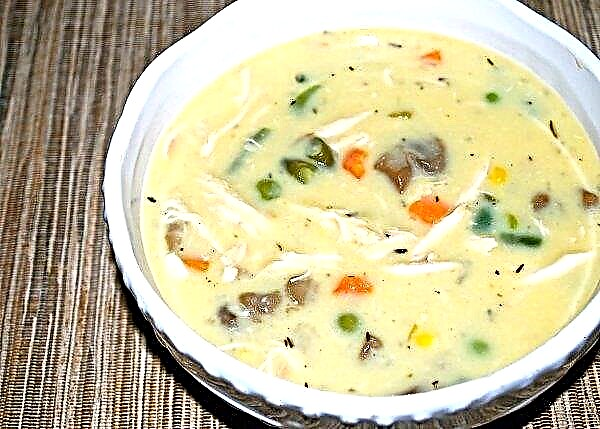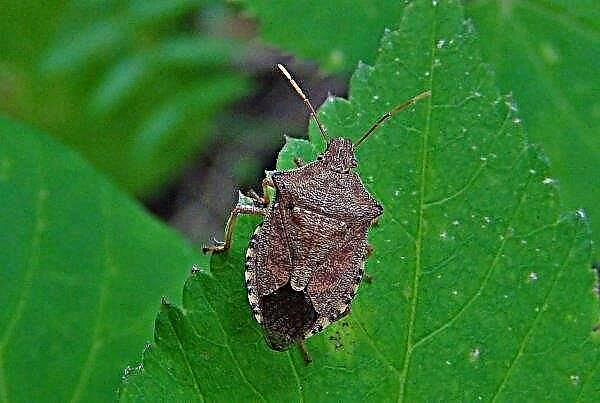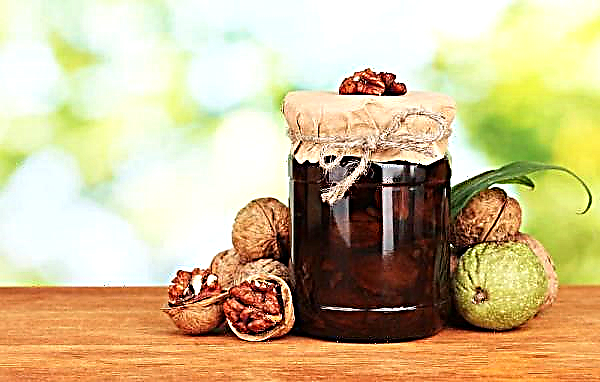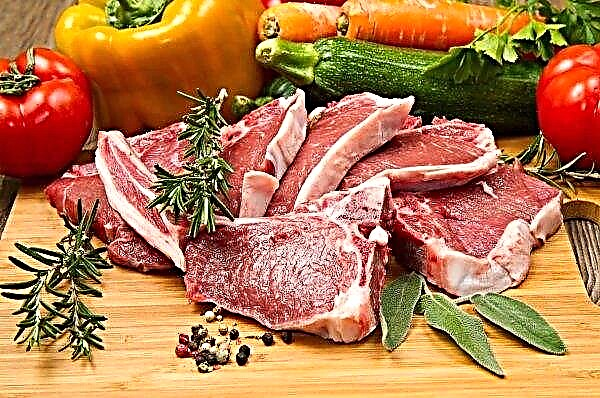Cucumbers do not bear fruit on soils poor in nutrients. One of the main nutritional elements of cucumber culture is nitrogen. About what fertilizers are, and how to feed them with plants in open / closed ground, we will discuss below.
What is nitrogen fertilizer?
Nitrogen fertilizers are organic and inorganic substances containing nitrogen in their composition. This element is the main building block of the plant cell cytoplasm. It is part of chlorophylls, proteins, nucleic acids and enzymatic elements.
Did you know? At the foot of the Himalayan mountains, wild cucumbers are still found. This area is considered the birthplace of culture.
What causes a lack of nitrogen?
In its natural form, nitrogen is contained in the atmosphere in an unlimited amount in a gaseous state, but not all plants are capable of converting it into an assimilable form, so most of them need additional recharge through soil or leaves.

Representatives of the flora, with the ability to convert the gaseous form into an easily digestible one, are characterized by the presence of nitrogen-fixing bacteria. Such microorganisms are produced by the root system of legumes. After they are removed from the site, a sufficient amount of this substance remains in the soil.
Other plants that do not have such features, without additional feeding, develop poorly and often get sick. The main danger of nitrogen deficiency is a significant decrease in yield and the risk of complete dying of plants.
- Signs of a deficiency of this element in cucumbers is:
- poor shoot formation;
- growth retardation;
- drooping, limp foliage;
- the development of fungal diseases against the background of a weakened immunity of the plant organism;
- change in color of the ground to yellow;
- late flowering;
- slow formation of the ovary;
- small fruits;
- quick shedding of the crop.
Video: how nitrogen deficiency manifests itself in cucumbers
Types of Nitrogen Fertilizer
In terms of origin, mineral and organic fertilizers containing nitrogen are isolated. By the number of active compounds among the minerals, complex and single-component compositions are distinguished, which are applied by the root or extra-root method (sprayed onto the sheet).
Did you know? So that the shabby surface of the shoe becomes like new, it is enough to wipe it with the pulp of fresh cucumber.
Organics
In a small amount, nitrogen is part of all types of litter. Typically, this indicator varies in the range of 0.5–1%, and in bird - 1–2.5%. The largest amount of this element is found in chicken, duck and pigeon droppings. However, these types of organics are also the most toxic.
Within 1.5%, nitrogen is contained in peat based compost. 0.4-0.7% of the substance includes legumes, clover, clover, and from 1 to 2.5% - river sludge.

Urea
Represents small white granules of white color, flavourless. After entering the soil, the main substance is converted under the influence of microflora into ammonium carbonate. Upon contact with air, nitrogen is converted to gaseous ammonia; therefore, the agent is applied directly to the soil to a depth of 7–10 cm or diluted in water. Top dressing can be used as root and extra root. When spraying on the sheet does not cause burns.
Important! Urea is not compatible with deoxidizing agents in the form of lime, chalk, wood ash, and superphosphate.
Urea is intended to accelerate the growth of the ground part of the plant, also to eliminate pests (aphids, coppers, weevils) and some types of fungal diseases (scab, purple spotting).
 Urea (urea) contains 46% nitrogen.
Urea (urea) contains 46% nitrogen.
When introduced into the budding period, they can provoke shedding. More effective in spring application. If you use it in the autumn when preparing the soil, before the onset of the season, the bulk of the nitrogen will already lose its qualities.
Ammonium nitrate
In appearance, this substance resembles urea, but its granules are larger and have a yellowish tint. Fertilizer is intended only for root top dressing of garden and indoor plants. It is diluted with water for irrigation or applied dry to moist soil to a depth of about 10 cm. When used for top dressing, ammonium nitrate leaves burns.
It is permissible to use ammonium nitrate for cucumbers right up to the start of fruit formation. It is not necessary to introduce the substance together with peat, sawdust or straw, because during their interaction a fire can occur.
 Ammonium nitrate (ammonium nitrate) contains 34% nitrogen.
Ammonium nitrate (ammonium nitrate) contains 34% nitrogen.
Calcium nitrate
The tool is an inorganic nitrate salt. The use of this type of fertilizer is justified on all types of soils. Particularly useful will be the application of funds on sod-podzolic and heavy podzolic soils with high acidity, on which other nitrogen fertilizing will cause even greater oxidation.
Important! Calcium nitrate is highly hygroscopic, therefore it is only necessary to store it in a well-sealed original packaging or pour it into a dry glass container with a tight-fitting lid.
Calcium nitrate is intended for feeding cucumbers and other garden crops at all phases of the growing season before flowering. It can be used as root and foliar top dressing.
 The composition of calcium nitrate is 13% nitrogen and 19% calcium.
The composition of calcium nitrate is 13% nitrogen and 19% calcium.
Sodium Nitrate
In this regard, it is used much less frequently than other types of nitrogen top dressing. The thing is that not all cultures tolerate an excess of sodium. In addition, it has the ability to accumulate in fruits.
For cucumbers, the use of sodium nitrate is justified only in the spring on large areas. Also, this fertilizer is not suitable for feeding plants cultivated in greenhouses or at home. In some cases, the substance begins to release toxic fumes even at room temperature.
 The composition of sodium nitrate includes about 17% of active nitrogen and 26% of sodium.
The composition of sodium nitrate includes about 17% of active nitrogen and 26% of sodium.
How to apply fertilizer?
To get a good crop of cucumbers, it is necessary to observe dosages and timelines, introducing nitrogenous top dressing. Otherwise, the culture will increase the lush ground part, and it will not have any left to form the fruits of forces.
In addition, most mineral fertilizing contributes to the accumulation of nitrates in the fruit, which is detrimental to human health. The most correct option is to combine the use of organics and minerals, focusing on the phases of plant vegetation.
Did you know? Spikes on cucumber fruits are used to remove excess moisture from them.
When cultivating plants in open ground and greenhouses, they begin to prepare the soil in the plots in the autumn. At this stage, it is best to use organics. In spring preparation, minerals should be preferred. In the future, until the beginning of flowering, fertilizing should be alternated.
In the open ground
At the first stage, in the fall, the site for planting cucumbers is cleaned of vegetation. Then digging the soil to a depth of 20-30 cm, and make disinfectants. You can use a 3% solution of copper sulfate. After a week, 6 kg of fresh cow manure or 300 g of dry chicken droppings + 5 kg of peat and sand are applied per m². Immediately dig the soil to a depth of 20 cm.
The next stage of preparation begins in early spring. For digging to a depth of 20 cm make 6 tbsp. l urea or 2 tbsp. ammonium nitrate per m². If calcium nitrate is used, then the consumption will be 3 tbsp. per m². If the winter turned out to be snowless and the soil is not wet enough, fertilizers should be planted in water - 30 liters per m². In addition to minerals, at this stage 10 kg of compost per m² are added.
After diving seedlings in open ground, the first nitrogen top dressing is done after 14 days. Under each plant, 5 g of urea is added, deepening into the soil by 5 cm or diluting in 1 liter of water. After 20 days, top dressing is performed with calcium nitrate on a sheet - 10 g of substance will be sufficient for 50 l of water.
After another 20 days, a compost-manure solution is introduced under the root. To do this, add 5 l of liquid mullein and 10 kg of fresh grass to 50 liters of water (nettle is best). The composition is insisted for a week, and then diluted in a ratio of 1: 1 with water. This top dressing will be the last before flowering. In the future, cucumbers will need more potassium and phosphorus, so the type of fertilizer is changed to correspond to the growing season.
In the greenhouse
When preparing the soil in the greenhouse at the autumn stage, the upper 20 cm of soil is changed. Then, the site is loosened to a depth of 20 cm and the premises are completely disinfected: special checkers are used inside, or the walls are washed with 7% solution of copper sulfate, and normal whiteness is used outside. After disinfection, thoroughly ventilate the room for 2 weeks.

Then replace the removed soil layer with a composition of:
- peat;
- sand;
- turf soil.
All elements are mixed in equal proportions. Then the soil is disinfected by spilling with a hot solution of manganese (1 g of substance is added to 1 liter of water). After a week, 6 kg of manure is applied to each m² of greenhouse and the soil layers are mixed well.
In the spring, dig the soil, make 10 kg of compost. After transplanting, in the phase of having 4 leaves, urea is fed. To 10 liters of water add 1 tbsp. substances. This will be enough to feed 10-15 plants.
After 20 days, 30 g of calcium nitrate, 10 g of ammonium nitrate and 20 g of superphosphate are diluted in 30 l of water. Make about 1 liter under the plant. After another 20 days, use an infusion of herbs. To 12 liters of water add 1 kg of chopped herbs of any herbs.
Insist a week, strain and pour 2-3 liters under each bush. At this point, they are trying to reduce the introduction of nitrogenous fertilizing to a minimum and move on to potash-phosphorus.

Useful tips gardeners
Some useful recommendations regarding nitrogen fertilizers for cucumbers from experienced farmers:
- If it is not possible to get manure, start composting yourself - organize a cesspool in which store tops of different garden crops, egg cleaning, tea brewing, coffee grounds, peeling potatoes and banana skins. In a year, all this will decay and become an excellent nitrogen fertilizer, which will also increase the humus content in the soil on the site.
- Strictly observe the recommended terms and standards for applying nitrogenous top dressing, otherwise nitrates will accumulate in the fruits at the time of harvest.
- Before using top dressing, you should first determine the need for parallel application of herbicides, fungicides or insecticides. If there is such a need, then to save money, you can choose a universal tool on the market that already contains all the necessary elements.
- If it is not possible to observe crop rotation for cucumbers, immediately after harvesting, plant green manure plants (cereals, legumes, phacelia, sweet clover or clover) in their place. Around the middle of October, dig the soil along the way, planting the roots and tops of these crops inland. During the winter, part of the vegetation will turn into humus, and nitrogen will remain in the soil.
Video: Nitrogen Fertilizer Application
Nitrogen is one of the main structural units of vegetation, especially its terrestrial part. Only a few cultures are able to absorb it from the atmosphere, and the rest for normal growth and development, including cucumbers, require additional recharge in the form of organic or inorganic compounds containing this element.



